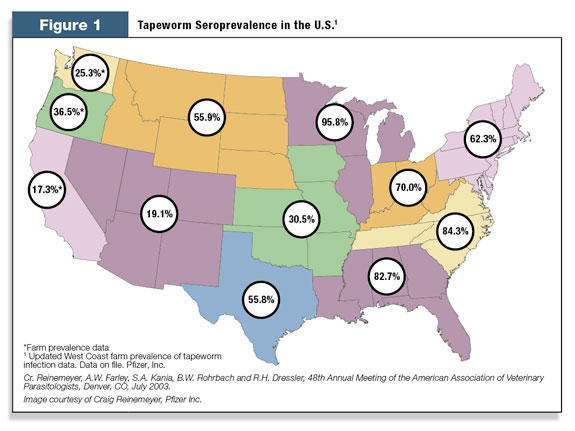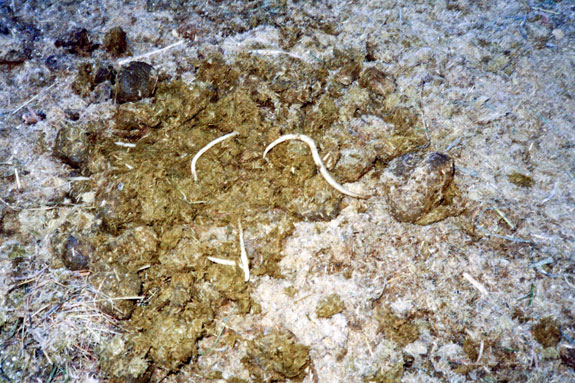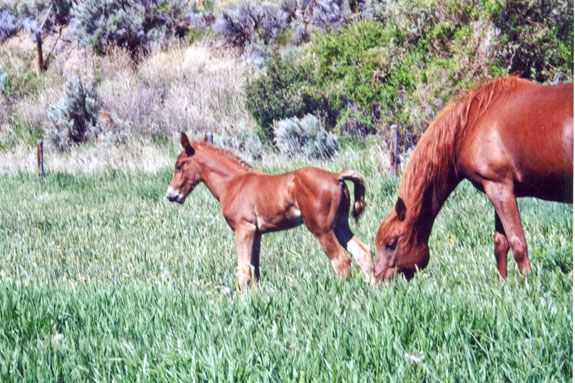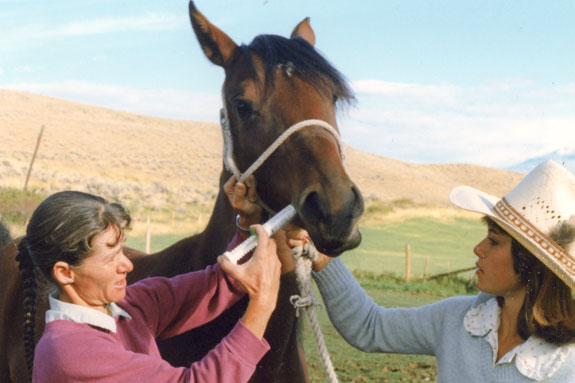These points will vary with the seasons, which in turn can vary with geography and climate.
A seasonal approach to deworming is always more effective than routine intervals, according to Craig R. Reinemeyer, DVM, PhD, and president of East Tennessee Clinical Research Inc.
Parasites must return to the environment between successive generations. The goal of control is to reduce their numbers in the horses’ environment so there is less chance for the animals to pick up worm eggs.
“In North America, the major differences in environmental and climatic conditions can be summarized as northern versus southern and confinement versus pasture,” he says. Parasite control issues will vary through the calendar year.
Late winter/early spring
Many northern horses are confined or in barns during winter, though they may be turned out for a while during the day.
“There’s not much worm transmission this time of year for mature confined horses, but your annual parasite control program should begin when horses are turned out on pasture – which may be April or May.

In the South, horses are more at risk for parasitism in late winter because they have probably been out on pasture.
Winter conditions are mild enough that a lot of worm transmission occurs through winter. Horses may be picking up worms all the time.
By late winter there may be nutritional stress on horses as well. Pastures are gone and you may be feeding hay.
Southern horses are probably exposed to more parasitism during this period than other months of the year, since parasite numbers on pastures decline dramatically during hot summer months,” explains Reinemeyer.
“The best way to make sure horses aren’t being exposed in late winter is to have done some parasite control in the fall – to keep them from contaminating pastures at that time.
You must look at the whole program as a continuing cycle throughout the year,” he says. Every point in the circle is affected by what took place previously.

Spring/summer
In the North, horses are turned out to pasture in spring. “They should be treated at least four or five days before they’re turned out.
The minimum parasite control for adult horses is to maintain eradication of large strongyles (S. vulgaris).
Most farms have already done this, and the simplest way is to treat with a larvicidal drug every six months and just keep that schedule.
Three products work for this: any of the ivermectins, moxidectin (Quest or Quest Plus), and Panacur Power-Pak.
Using any of these at roughly six-month intervals will work, and no matter what your climate is, spring and fall are probably the ideal times to do this.
In the North especially, however, it should be done before horses are turned out to pasture in spring,” he says.
“Southern regions have the same recommendations for large strongyles. Northern horses are more at risk, however, because their egg counts will spike in the spring, and worms will intensely contaminate pastures. In the South it becomes a self-limiting thing as weather heats up,” he says.
“By summer you need to think about ascarid control in foals. We’ve been treating too much for these, however, and should back off on the onset and frequency.

Foals should not be treated routinely for any worms until they are at least 60 days old. Treatment is not likely to be very effective at a younger age.
Young foals may have some parasites, but they are ones we probably can’t do much about; efficacy of the dewormers gets better as the worms get older.
The younger the worm is when you expose it to the drug, the less likely the drug will work,” he explains.
It’s best to give foals as much time as you can before deworming the first time. “After that it gets tricky regarding intervals of deworming for foals.
We are starting to see resistance of roundworms to the macrocyclic lactone class of drugs, which includes ivermectin and moxidectin.
Dr. Gene Lyons at the University of Kentucky has found a local ascarid strain that’s resistant to the second class of drugs as well. This is mostly due to overusing these drugs,” he says.
In the southern U.S, he doesn’t recommend using any dewormers during hot, dry summer months, at least in mature horses.
“In foals you could maintain minimum control recommendations for ascarids. In the North, summer is a more important season of transmission than winter and more important than summer in the South, so you may want to maintain some type of strongyle control through the summer.
I don’t recommend deworming the whole herd. We can do some simple testing and find out which horses need help and base our control recommendations on individual horses,” he says.

Fall/early winter
Spring and fall are usually ideal seasons for worm transmission in nearly every climate, due to moist, moderate temperatures.
Fall is the other time of year to implement the every-six-month treatment for large strongyles, to maintain eradication.
“Since this is the time we are deworming every horse on the place, it’s also a good time to use something for tapeworms. I
f using Quest, you can simply use Quest Plus. If you’re using an ivermectin, you can use Equimax or Zimectrin Gold.
All three of these products include praziquatal to kill tapeworms as well as maintain eradication of large strongyles,” says Reinemeyer.
“Northern horses may start going indoors for winter and then the worm problems are over for that season. In the South, it’s important for people to realize that fall is the start of their annual transmission season.
It’s more important to do parasite control early on, in the cool months, rather than later. It’s similar to what people try to do in the North in the spring, to try to keep pastures clean as long as you can.
The major difference is that in the North the pastures keep growing during summer, and this dilutes the parasites.
But in the South, winter pastures may stop growing and horses just keep eating the plants shorter and shorter, and this increases the risk of exposure to worms.
” The larvae are always on the lowest part of the plant near the ground, so the closer a pasture is grazed, the more worms will be picked up.
In the fall we traditionally treat for bots after the first hard frost – whenever it happens in your region. Once the flies are gone, there are no new eggs laid on the horse.
“Some of the eggs already on the hair coat may continue to infect the horse for weeks, so there can be transmission continuing into winter.
But if you have to pick a single time of year to get the most for your money from one treatment, it would be late autumn/early winter,” he explains. ![]()
PHOTOS
TOP: Horse being dewormed
MIDDLE: A mare and foal on pasture. Experts say it’s not effective to worm young foals; you should wait until they are at least 60 days old.
MIDDLE: This photo shows adult roundworms that were passed in the manure after deworming a 6-month-old foal.
BOTTOM: An old horse being dewormed. Photo courtesy of Heather Smith Thomas.







